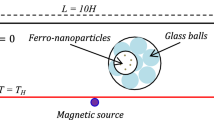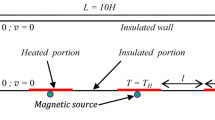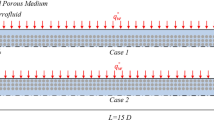Abstract
In this paper, a two-phase model is used to study Fe3O4/H2O magnetic nanofluid laminar forced convection in a uniformly heated pipe and under the influence of a quadrupole magnetic field. The extended model considers the three primary transport mechanisms of magnetic nanoparticles in the carrier liquid, namely Brownian diffusion, thermophoresis, and magnetophoresis. Governing equations are solved numerically utilizing a SIMPLE-based finite volume method. Computations are performed for various important parameters including magnetic and Reynolds numbers, particle size and volume fraction, and the magnetic source length. Numerical results show that some vortices are formed due to magnetic field which leads to heat transfer augmentation. It is found that in the sections where the magnetic field is applied, the particle distribution is almost uniform, and also the radial component of Brownian, thermophoresis, and magnetophoresis fluxes are comparable. Far away from the magnetic field, there is an obvious non-uniform particle distribution because of the thermophoretic diffusion. Numerical results indicate that the heat transfer enhancement is an increasing function of the magnetic number, particle size, and volume fraction, while a decreasing function of the magnetic source length and Reynolds number. Multiple magnetic sources provide higher heat transfer rates and hydro-thermal performance. The obtained simulation results reveal that such a magnetic field can increase the heat transfer rate more than three times.





















Similar content being viewed by others
Abbreviations
- c :
-
Specific heat at constant pressure (J kg−1 K−1)
- D :
-
Pipe diameter (m)
- \( D_{\text{B}} \) :
-
Brownian diffusivity (m2 s−1)
- \( d_{\text{p}} \) :
-
Particle diameter (m)
- \( D_{\text{T}} \) :
-
Thermophoretic diffusivity (m2 s−1)
- H :
-
Magnetic field intensity (A m−1)
- \( J_{\text{p}} \) :
-
Particle mass flux vector (kg m−2 s−1)
- k :
-
Thermal conductivity (W m−1 K−1)
- \( k_{\text{B}} \) :
-
Boltzmann constant (\( 1.380648 \times 10^{ - 23} \) J K−1)
- \( L_{\text{m}} \) :
-
Magnetic source length (m)
- M s :
-
Saturation magnetization (A m−1)
- \( {\text{Mn}} = \frac{{\mu_{\text{o}} H_{\text{o}}^{2} D^{2} }}{{\rho_{\text{f}} \alpha_{\text{f}}^{2} }} \) :
-
Magnetic number (−)
- \( m_{\text{p}} \) :
-
Magnetic moment of nanoparticles (A m2)
- \( {\text{Nu}} = \frac{1}{{T_{\text{w}}^{ *} \left( {z^{ *} } \right) - T_{\text{m}}^{ *} \left( {z^{ *} } \right)}} \) :
-
Nusselt number (−)
- p :
-
Pressure (Pa)
- \( { \Pr } = \frac{{\left( {\mu c} \right)_{\text{f}} }}{{k_{\text{f}} }} \) :
-
Prandtl number (−)
- q″:
-
Heat flux (W m−2)
- \( q^{ *} = \frac{{q_{\text{w}}^{''} D}}{{k_{\text{f}} T_{\text{in}} }} \) :
-
Non-dimensional heat flux (−)
- r :
-
Radial coordinate (m)
- \( {\text{Re}} = \frac{{V_{\text{in}} D}}{{\upsilon_{\text{f}} }} \) :
-
Reynolds number (−)
- T :
-
Temperature (K)
- \( T_{\text{m}} \) :
-
Mean fluid temperature (K)
- \( V_{\text{r}} , V_{\text{z}} \) :
-
Velocity components (m s−1)
- z :
-
Axial coordinate (m)
- \( \alpha_{\text{f}} \) :
-
Thermal diffusivity (m2 s−1)
- \( \mu \) :
-
Dynamic viscosity (Pa s−1)
- \( \mu_{\text{B}} \) :
-
Bohr magneton (\( 9.274 \times 10^{ - 24} \) A m2)
- \( \mu_{\text{o}} \) :
-
Vacuum permeability (TmA−1)
- \( \xi = \frac{{\mu_{\text{o}} m_{\text{p}} H}}{{k_{\text{B}} T}} \) :
-
Langevin parameter (−)
- \( \rho \) :
-
Density (kg m−3)
- \( \phi \) :
-
Particle volume fraction (−)
- \( \chi \) :
-
Magnetic susceptibility (−)
- f:
-
Base fluid
- ff:
-
Ferrofluid
- in:
-
Inlet
- p:
-
Nanoparticle
- w:
-
Wall
References
S. Kakaç, A. Pramuanjaroenkij, Review of convective heat transfer enhancement with nanofluids. Int. J. Heat Mass Transf. 52, 3187–3196 (2009). https://doi.org/10.1016/j.ijheatmasstransfer.2009.02.006
M.U. Sajid, H.M. Ali, Recent advances in application of nanofluids in heat transfer devices: a critical review. Renew. Sustain. Energy Rev. 103, 556–592 (2019). https://doi.org/10.1016/j.rser.2018.12.057
J.S. Mehta, R. Kumar, H. Kumar, H. Garg, Convective heat transfer enhancement using ferrofluid: a review. J. Therm. Sci. Eng. Appl. (2018). https://doi.org/10.1115/1.4037200
S. Odenbach, Ferrofluids—magnetically controlled suspensions, in: colloids surfaces a physicochem. Eng. Asp. (2003). https://doi.org/10.1016/S0927-7757(02)00573-3
R.E. Rosensweig, Ferrohydrodynamics, vol. 116 (Cambridge University Press, Cambridge, 1985)
M. Bahiraei, M. Hangi, Flow and heat transfer characteristics of magnetic nanofluids: a review. J. Magn. Magn. Mater. 374, 125–138 (2015). https://doi.org/10.1016/j.jmmm.2014.08.004
M.A. Khairul, E. Doroodchi, R. Azizian, B. Moghtaderi, Advanced applications of tunable ferrofluids in energy systems and energy harvesters: a critical review. Energy Convers. Manag. 149, 660–674 (2017). https://doi.org/10.1016/j.enconman.2017.07.064
R.J. Yang, H.H. Hou, Y.N. Wang, L.M. Fu, Micro-magnetofluidics in microfluidic systems: a review. Sens. Actuators B Chem. 224, 1–15 (2016). https://doi.org/10.1016/j.snb.2015.10.053
Q. Li, W. Lian, H. Sun, Y. Xuan, Investigation on operational characteristics of a miniature automatic cooling device. Int. J. Heat Mass Transf. 51, 5033–5039 (2008). https://doi.org/10.1016/j.ijheatmasstransfer.2008.04.031
Y. Xuan, W. Lian, Electronic cooling using an automatic energy transport device based on thermomagnetic effect. Appl. Therm. Eng. 31, 1487–1494 (2011). https://doi.org/10.1016/j.applthermaleng.2011.01.033
K. Zimmermann, I. Zeidis, V. Böhm, S. Greiser, J. Popp, Ferrofluid-based flow manipulation and locomotion systems. J. Intell. Mater. Syst. Struct. 21, 1559–1562 (2010). https://doi.org/10.1177/1045389X09354789
H. Shokrollahi, Structure, synthetic methods, magnetic properties and biomedical applications of ferrofluids. Mater. Sci. Eng. C 33, 2476–2487 (2013). https://doi.org/10.1016/j.msec.2013.03.028
V.F. Cardoso, A. Francesko, C. Ribeiro, M. Bañobre-López, P. Martins, S. Lanceros-Mendez, Advances in magnetic nanoparticles for biomedical applications. Adv. Healthc. Mater. 7, 1700845 (2018). https://doi.org/10.1002/adhm.201700845
W. Huang, X. Wang, Ferrofluids lubrication: a status report. Lubr. Sci. 28, 3–26 (2016). https://doi.org/10.1002/ls.1291
H. Urreta, G. Aguirre, P. Kuzhir, L.N. Lopez de Lacalle, Seals based on magnetic fluids for high precision spindles of machine tools. Int. J. Precis. Eng. Manuf. 19, 495–503 (2018). https://doi.org/10.1007/s12541-018-0060-9
C. Huang, J. Yao, T. Zhang, Y. Chen, H. Jiang, D. Li, Damping applications of ferrofluids: a review. J. Magn. 22, 109–121 (2017). https://doi.org/10.4283/JMAG.2017.22.1.109
M. Goharkhah, M. Ashjaee, Effect of an alternating nonuniform magnetic field on ferrofluid flow and heat transfer in a channel. J. Magn. Magn. Mater. 362, 80–89 (2014). https://doi.org/10.1016/j.jmmm.2014.03.025
S. Shyam, B. Mehta, P.K. Mondal, S. Wongwises, Investigation into the thermo-hydrodynamics of ferrofluid flow under the influence of constant and alternating magnetic field by InfraRed Thermography. Int. J. Heat Mass Transf. 135, 1233–1247 (2019). https://doi.org/10.1016/j.ijheatmasstransfer.2019.02.050
A. Shakiba, K. Vahedi, Numerical analysis of magnetic field effects on hydro-thermal behavior of a magnetic nanofluid in a double pipe heat exchanger. J. Magn. Magn. Mater. 402, 131–142 (2016). https://doi.org/10.1016/j.jmmm.2015.11.039
A. Khosravi, M. Malekan, M.E.H. Assad, Numerical analysis of magnetic field effects on the heat transfer enhancement in ferrofluids for a parabolic trough solar collector. Renew. Energy 134, 54–63 (2019). https://doi.org/10.1016/j.renene.2018.11.015
F. Fadaei, M. Shahrokhi, A. Molaei Dehkordi, Z. Abbasi, Forced-convection heat transfer of ferrofluids in a circular duct partially filled with porous medium in the presence of magnetic field. J. Magn. Magn. Mater. 475, 304–315 (2019). https://doi.org/10.1016/j.jmmm.2018.11.032
F. Fadaei, M. Shahrokhi, A. Molaei Dehkordi, Z. Abbasi, Heat transfer enhancement of Fe3O4 ferrofluids in the presence of magnetic field. J. Magn. Magn. Mater. 429, 314–323 (2017). https://doi.org/10.1016/j.jmmm.2017.01.046
M.H. Hekmat, K.K. Ziarati, Effects of nanoparticles volume fraction and magnetic field gradient on the mixed convection of a ferrofluid in the annulus between vertical concentric cylinders. Appl. Therm. Eng. 152, 844–857 (2019). https://doi.org/10.1016/j.applthermaleng.2019.02.124
Y. Sheikhnejad, R. Hosseini, M. Saffar-Avval, Effect of different magnetic field distributions on laminar ferroconvection heat transfer in horizontal tube. J. Magn. Magn. Mater. 389, 136–143 (2015). https://doi.org/10.1016/j.jmmm.2015.04.029
A. Favakeh, M.A. Bijarchi, M.B. Shafii, Ferrofluid droplet formation from a nozzle using alternating magnetic field with different magnetic coil positions. J. Magn. Magn. Mater. 498, 166134 (2020). https://doi.org/10.1016/j.jmmm.2019.166134
M.A. Bijarchi, M.B. Shafii, Experimental investigation on the dynamics of on-demand ferrofluid drop formation under a pulse-width-modulated nonuniform magnetic field. Langmuir (2020). https://doi.org/10.1021/acs.langmuir.0c00097
M.A. Bijarchi, A. Favakeh, M.B. Shafii, The effect of a non-uniform pulse-width modulated magnetic field with different angles on the swinging ferrofluid droplet formation. J. Ind. Eng. Chem. 84, 106–119 (2020). https://doi.org/10.1016/j.jiec.2019.12.026
M. Zarei Saleh Abad, M. Ebrahimi-Dehshali, M.A. Bijarchi, M.B. Shafii, A. Moosavi, Visualization of pool boiling heat transfer of magnetic nanofluid. Heat Transf. Asian Res. 48, 2700–2713 (2019). https://doi.org/10.1002/htj.21498
A. Bozhko, T. Tynjälä, Influence of gravitational sedimentation of magnetic particles on ferrofluid convection in experiments and numerical simulations. J. Magn. Magn. Mater. 289, 281–284 (2005). https://doi.org/10.1016/j.jmmm.2004.11.080
H. Aminfar, M. Mohammadpourfard, S. Ahangar Zonouzi, Numerical study of the ferrofluid flow and heat transfer through a rectangular duct in the presence of a non-uniform transverse magnetic field. J. Magn. Magn. Mater. 327, 31–42 (2013). https://doi.org/10.1016/j.jmmm.2012.09.011
A. Asadi, A. Hossein Nezhad, F. Sarhaddi, T. Keykha, Laminar ferrofluid heat transfer in presence of non-uniform magnetic field in a channel with sinusoidal wall: a numerical study. J. Magn. Magn. Mater. 471, 56–63 (2019). https://doi.org/10.1016/j.jmmm.2018.09.045
M. Bahiraei, M. Hangi, A. Rahbari, A two-phase simulation of convective heat transfer characteristics of water–Fe3O4 ferrofluid in a square channel under the effect of permanent magnet. Appl. Therm. Eng. 147, 991–997 (2019). https://doi.org/10.1016/j.applthermaleng.2018.11.011
J. Buongiorno, Convective transport in nanofluids. J. Heat Transf. 128, 240–250 (2006). https://doi.org/10.1115/1.2150834
W. Nessab, H. Kahalerras, B. Fersadou, D. Hammoudi, Numerical investigation of ferrofluid jet flow and convective heat transfer under the influence of magnetic sources. Appl. Therm. Eng. 150, 271–284 (2019). https://doi.org/10.1016/j.applthermaleng.2018.12.164
M.Z.J.J. Chalmers, Magnetic Cell Separation, vol. 32, 1st edn. (Elsevier, Amsterdam, 2007)
B.C. Pak, Y.I. Cho, Hydrodynamic and heat transfer study of dispersed fluids with submicron metallic oxide particles. Exp. Heat Transf. 11, 151–170 (1998). https://doi.org/10.1080/08916159808946559
Y. Xuan, W. Roetzel, Conceptions for heat transfer correlation of nanofluids. Int. J. Heat Mass Transf. 43, 3701–3707 (2000). https://doi.org/10.1016/S0017-9310(99)00369-5
H.C. Brinkman, The viscosity of concentrated suspensions and solutions. J. Chem. Phys. 20, 571 (1952). https://doi.org/10.1063/1.1700493
J.C. Maxwell, A treatise on electricity and magnetism. Nature 7, 478–480 (1873). https://doi.org/10.1038/007478a0
F.P. Incropera, D.P. DeWitt, Fundamentals of Heat and Mass Transfer (Wiley, Hoboken, 1996). https://doi.org/10.1016/j.applthermaleng.2011.03.022
L. Syam-Sundar, M.T. Naik, K.V. Sharma, M.K. Singh, T.C. Siva-Reddy, Experimental investigation of forced convection heat transfer and friction factor in a tube with Fe3O4 magnetic nanofluid. Exp. Therm. Fluid Sci. 37, 65–71 (2012). https://doi.org/10.1016/j.expthermflusci.2011.10.004
H. Yamaguchi, <[H._Yamaguchi__(auth.)]_Engineering_Fluid_Mechanic(BookZZ.org).pdf> (Springer, Dordrecht, 2008)
M.I. Shliomis, in Thermal Nonequilibrium Phenomena in Fluid Mixtures (Springer, Berlin, Heidelberg, 2002), pp. 355–371
M.I. Shliomis, B.L. Smorodin, Convective instability of magnetized ferrofluids. J. Magn. Magn. Mater. 252, 197–202 (2002). https://doi.org/10.1016/S0304-8853(02)00712-6
S.Y. Motlagh, H. Soltanipour, Natural convection of Al2O3–water nanofluid in an inclined cavity using Buongiorno’s two-phase model. Int. J. Therm. Sci. 111, 310–320 (2017). https://doi.org/10.1016/j.ijthermalsci.2016.08.022
R.L. Webb, N.H. Kim, Principles of Enhanced Heat Transfer (Tylayer Fr. Routledge, New York, 2005)
S.V. Patankar, Numerical Heat Transfer and Fluid Flow (Hemisphere Publishing Corporation, New York, 1980), p. 58
M. Asfer, B. Mehta, A. Kumar, S. Khandekar, P.K. Panigrahi, Effect of magnetic field on laminar convective heat transfer characteristics of ferrofluid flowing through a circular stainless steel tube. Int. J. Heat Fluid Flow 59, 74–86 (2016). https://doi.org/10.1016/j.ijheatfluidflow.2016.01.009
M. Corcione, M. Cianfrini, A. Quintino, Two-phase mixture modeling of natural convection of nanofluids with temperature-dependent properties. Int. J. Therm. Sci. 71, 182–195 (2013). https://doi.org/10.1016/j.ijthermalsci.2013.04.005
Author information
Authors and Affiliations
Corresponding author
Rights and permissions
About this article
Cite this article
Soltanipour, H. Two-phase simulation of magnetic field effect on the ferrofluid forced convection in a pipe considering Brownian diffusion, thermophoresis, and magnetophoresis. Eur. Phys. J. Plus 135, 702 (2020). https://doi.org/10.1140/epjp/s13360-020-00725-w
Received:
Accepted:
Published:
DOI: https://doi.org/10.1140/epjp/s13360-020-00725-w




